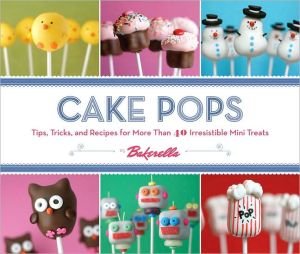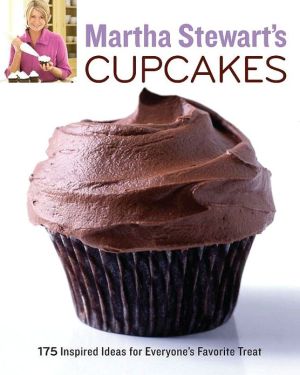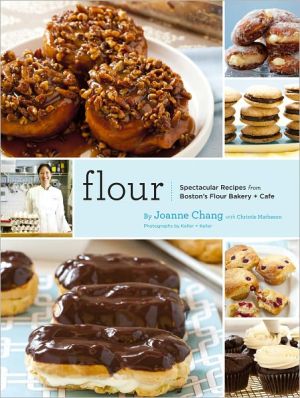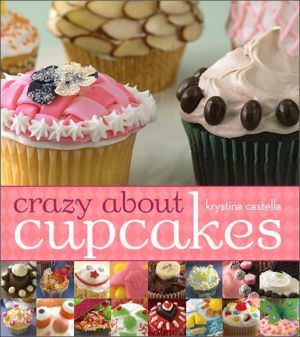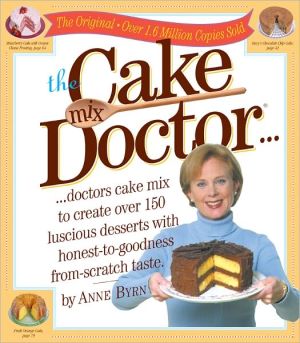Cakes to Dream On: A Master Class in Decorating
Colette peters, the celebrated queen of the confectionary arts, unveils an inspiring resource for serious home bakers, professional chefs, and aficionados of Colette's incredible edible architecture. The ingenious cake decorator - whose miraculous and luscious concoctions have appeared everywhere from White House Christmases to royal weddings - presents a master class in cake design and decoration, alongside an all-new selection of her own cake designs. With Cakes to Dream On, Colette's...
Search in google:
Colette peters, the celebrated queen of the confectionary arts, unveils an inspiring resource for serious home bakers, professional chefs, and a cionados of Colette’s incredible edible architecture. The ingenious cake decorator--whose miraculous and luscious concoctions have appeared everywhere from White House Christmases to royal weddings--presents a master class in cake design and decoration, alongside an all-new selection of her own cake designs. With Cakes to Dream On, Colette’s inspired creations can now be rendered into show-stopping cakes of your own.Cakes to Dream On reveals the secrets to fashioning gorgeous and utterly distinctive cakes for all occasions--whether it’s an opulent marriage reception (the majestic Ivory Wedding Cake) or a fanciful children’s party (the whimsical Homage to Dr. Seuss). Colette presents designs for cake architecture ranging from the imperial splendor of Dolce de Medici, to the elegant grace of Bride’s Vintage Cameo, to the topsy-turvy daydream of Mad Tea Party. Colette begins with the foundations: she illuminates step by step the process of constructing a multitiered cake, from determining serving sizes and choosing appropriate cake pans to making llings, and ultimately stacking layers so they don’t tumble off the table. Cakes to Dream On also discloses insider tricks of the trade: Colette’s easy-to-follow instructions in techniques such as sugarwork, gumpaste, brush embroidery, and piping will help readers recreate the spectacular effects of this singular confectioner’s toolbox. Bakers--and their enthusiastic audiences--will discover that these sensual masterpieces tantalize the palate as much as they do the eye. Colette’s cake recipes include the Coco-Loco Cake, an alluring marriage of coconut and coffee; the Meringue Buttercream and its luscious lemon, raspberry, and mocha variants; and the ambrosial caramel-tinged Heavenly White Cake. As breathtaking as Colette’s cake works appear, her clear explanations of technique are meant to stimulate readers’ creative instincts and give them ideas for crafting their own distinctive confections. With more than 150 dazzling full-color photographs illustrating both processes and nished presentations, and more detailed instruction than ever before, Cakes to Dream On will inspire readers to create their own mouthwatering masterpieces. Colette’s master class is truly a launchpad for cake lovers’ own confectionary visions.
Cakes to Dream On\ A Master Class in Decorating \ \ By Colette Peters \ John Wiley & Sons\ ISBN: 0-471-21462-0 \ \ \ Chapter One\ How to Make a Decorated Cake \ Plan the architecture of the cake.\ Decide how many servings you need so you can design the right-size cake.\ Choose appropriate cake pans for the size and shape you are planning.\ Make all of the decorations that can be prepared in advance.\ Make the base that will hold the cake and cover it with royal icing.\ Bake the cakes and let them cool. Also prepare the fillings and icings.\ Make foamcore boards for each tier.\ Cut the cakes, fill them, and crumb-coat them. Chill well before decorating.\ Cover the cakes with fondant.\ Insert dowels for double- or multitiered cakes.\ Stack the cakes on the base.\ Put at least one supporting dowel through the entire cake to reinforce the cake for delivery.\ Decorate the cake.\ Baking a cake is easy. What you do with that cake next is a little more difficult. Before you bake the cake, the first things you have to determine are what the occasion is, the design you want to make, and the number of people you need to feed.\ How to Start\ SERVINGS\ Knowing the number of servings is the first thing that determines the size of the cake. You can't, for example, make a cake for 25 people that's 15 tiers high. Nor, on the otherhand, can you make a cake for 300 that's only one tier high (unless you have really wide doorways). Most cake recipes yield approximately 6 cups of batter, or enough to serve about 20 people.\ The following table indicates how many servings you can expect to get out of cakes of various shapes and sizes. This chart will also help you determine how many recipes of cake you will need. To ensure maximum baking efficiency, each pan should be filled only halfway. Although serving sizes will vary depending on who is cutting the cake, the numbers of servings listed below are based on pieces about 3 to 4 inches high and 1 by 2 inches wide.\ CAKE PANS\ Cake Shape and Size Number of Servings\ ROUND, HEXAGON, OR OCTAGON\ 6 inch 10 8 inch 20 10 inch 30 12 inch 50 14 inch 70 16 inch 100 18 inch 125\ OVAL\ 8 inch 15 10 inch 25 13 inch 40 16 inch 60\ SQUARE\ 6 inch 15 8 inch 25 10 inch 40 12 inch 70 14 inch 100 16 inch 125\ PETAL SHAPE\ 6 inch 8 9 inch 20 12 inch 35 15 inch 60\ HEART SHAPE\ 6 inch 8 9 inch 20 12 inch 45 15 inch 70\ DECORATIONS\ Make as many decorations as you can in advance so you don't have to rush to finish them at the last minute.\ CAKE BASES\ The board that the cake sits on may not seem like an important thing to think about, but when you start making cakes that are large and heavy, the board will soon become very important. The base must be strong enough to support the cake's weight, and it should look like it's part of the overall design, not something simply utilitarian. I often make the base at least 4 inches larger than the bottom cake tier, usually larger. If you plan to put flowers or other decorations around the bottom edge, make sure the base is big enough to accommodate them. I think that a wider base makes the cake look more impressive.\ Bases can be made from many materials, including wood, Plexiglas, metal, foamcore, and fiberboard. Wood and Plexiglas are strong, but also heavy and difficult to cut into circles or odd shapes, and Plexiglas can be very expensive. I find that ready-made 1/2-inch-thick fiberboard drums and 1/2-inch-thick foamcore boards are the strongest and lightest choices. They are available at cake-decorating stores and at craft stores. You can cover these boards with thinned royal icing to match the cake and not worry about the board warping. Another advantage to these is that when you are constructing your cake, you may need to insert a dowel into the entire cake for support. This dowel should also go into the board to keep the cake from sliding, and these are the only kinds of boards that will allow you to do this.\ You can make your own bases by gluing together two or more sheets of 3/16-inch-thick foamcore, then cutting it with an X-acto knife to the size and shape you want. Unless the cake is very small (6 to 9 inches), don't use a single layer of foamcore because the board may bend from the weight of the cake when you lift it. If a base bends, it will crack the cake.\ Covering the base with thinned royal icing is one way to give the board a professional finish. You can tint the icing to match the color of the cake or to contrast with it. To cover a board with royal icing, thin enough icing to cover the board by adding a few drops of water at a time until the icing is the consistency of thick syrup. Add a few drops of liquid food coloring to the icing to match a colored cake, if you wish. Pour the icing onto the board and smooth it with an offset spatula. Let it dry overnight. Attach a ribbon around the edge of the board with white or hot glue. The ribbon should be the same thickness as the edge of the board.\ Another way to cover a board is to use food-grade foil. This can be found at cake-decorating stores. Place the paper on the board with about 2 inches extra all around to wrap under. Tape the paper under the board, stretching the sections tightly as you go.\ CAKES AND FILLINGS\ Create the cakes, fillings, and icings that you can mix and match.\ CAKE ARCHITECTURE\ Once you know what size and shape cake you are going to make, then you can bake the cakes and make the icing. I always bake cakes in pans whose bottoms are covered with a piece of parchment, which I first spray with a coating of vegetable oil. By doing this, you can cool the cakes completely in the pans, refrigerate them, and then remove them easily when they are cold. Just run a knife or metal spatula around the inside of the pan to separate the cake from the sides. A cake that is properly baked will pull away from the sides of the pan when it is done, so there shouldn't be much sticking. The cake will then come out of the pan easily with a quick tap when held upside down. And since the cake is now cool, it will be firm enough to hold together. Cakes crack if they are removed from the pan too soon.\ To prepare a multitiered cake, first you need a support on which to place each tier, such as cardboard or foamcore. You can buy ready-made cardboard, which comes in the same sizes and shapes as most cake pans, or you can make your own cakeboard out of foamcore, which I recommend. To do this, place the bottom of the pan in which your cake was baked on a piece of foamcore, trace the outline, and cut it out with a sharp X-acto knife.\ FILLINGS AND CRUMB-COATINGS\ When you are ready to construct the cake, slice each cake horizontally to prepare it for the filling. My cakes are usually made in two pans, with each cake sliced in half. This will give you four layers of cake and three layers of filling. Place the bottom of one of the split layers on your foamcore board, attaching it with a little of the filling. Spread some filling on the cake and then place the next layer of cake on top. Continue adding layers and filling, but leave the bottom of one of the layers for the top so the top of the cake is flat. Place this layer on top of the last filled layer, with the bottom up. At this point, you can trim the layer to make sure that it is perfectly horizontal and straight. Crumb-coating is a layer of icing you spread on the cake to seal in the cake crumbs, smooth the surface, and help the fondant adhere to the sides of the cake. Next, crumb-coat the whole cake with a thin layer of icing, filling any gaps between the layers so that the cake is perfectly smooth for receiving the fondant layer. Refrigerate until the icing is firm.\ FONDANT\ Now you are ready to cover the cake with fondant. Dust a clean, smooth surface with cornstarch or confectioners' sugar. This will prevent the fondant from sticking to the table. Also, make sure you have enough fondant to cover the entire cake. Here is a guide to how much fondant you will need to cover a 4-inch-high cake:\ Cake Shape and Size Pounds of Fondant\ ROUND, OCTAGON, PETAL, HEART, OR OVAL\ 6 inch 1 1/2 8 inch 2 10 inch 2 1/2 12 inch 3 14 inch 4 16 inch 5\ SQUARE\ 6 inch 2 8 inch 2 1/2 10 inch 3 12 inch 4 14 inch 5 16 inch 6 1/2\ Roll out the fondant with a rolling pin, giving it a half-turn after every few rolls to make sure it's not sticking to the table and to make sure that you're rolling it evenly. It should be about 1/4 inch thick when you put it on the cake. Slide your hands, palms up, under the fondant and center it on top of the cake (Figure 1). Smooth the top of the cake, then smooth the top edge. Pull the folds sideways to flatten them, then gently press to the side of the cake. Cut off the excess fondant around the bottom edge with a pizza cutter. (You can reuse the extra fondant; just make sure there is no residue from the crumb-coating before you store it-this could get moldy eventually.)\ DOWELS\ When you have more than one tier, you need to put dowels in the lower tiers to support the weight of the other tiers. Start stacking the cakes on the prepared royal icing-covered base. First, place the bottom tier on the base, using a little royal icing to "glue" the cake in place. Take the pan in which the next smaller tier was baked in and place it on top of the bottom tier. Use a toothpick to emboss the outline of the pan in the fondant so you will have a boundary within which to place the dowels. Insert a dowel all the way into the center of the bottom tier and mark the place on the dowel where it is level with the top of the fondant. Remove the dowel and cut it at the mark with a pair of clippers. Cut as many dowels as you need for this tier, making them the same height as the first dowel. Insert dowels in the center and around the inside of the outline-the wider the tier, the more dowels you will need. Smaller tiers need fewer dowels, and the top tier doesn't need any unless you are putting a heavy ornament on top (Figure 2).\ STACK THE CAKES\ Use royal icing to "glue" one tier on top of another tier.\ REINFORCING THE CAKE FOR DELIVERY\ If you are going to deliver the cake stacked, you should put a dowel through the entire cake to keep it from shifting during delivery. First, measure the height of the whole cake, then cut a dowel to that length. Sharpen one end of the dowel to a point and push it through all of the tiers and the boards. When you get near the top, use a hammer to gently tap the dowel through the rest.\ DECORATIONS\ Finally, you are ready to start decorating. Whew!\ Double-Layered Cakes\ If your design calls for a tier that is going to be much more than 4 inches high, you need to separate it, as if it were two tiers, so that the slices of cake are not bigger than the plate. Start by stacking the layers on a foamcore board, as mentioned earlier, but rather than just piling cake layer upon cake layer, stop midway (for example, if the cake is going to be 6 inches high, stop at 3 inches) and crumb-coat the cake. Then, put a piece of rolled fondant only on the top of the cake, and insert dowels. Place the next layer of cake, which will also be on a board, on top of the fondant with the dowels. Finally, crumb-coat the whole cake. Chill and then cover the cake with fondant as you normally would. Insert a sharpened dowel through the entire cake (Figure 3).\ When the upper tier is cut, the knife will go down until it hits the middle board. That tier will be cut, the board will be removed, and then the bottom tier will be cut. So, when you are figuring how many servings you'll have, if the cake is 10 inches high, which usually serves 30, you should figure that it will serve 60, since it is a double layer.\ Making a Cake Crooked, on Purpose\ I made my first topsy-turvy cake for a book by John Loring entitled Tiffany Taste, in 1985. I was asked by him to make something wacky and whimsical, but had no other guidelines, so I was a little nervous. I thought making a crooked cake would be playful and ironic, since making a cake as straight as possible so it doesn't fall over is the number one goal of every cake maker. I don't think I had ever before seen a cake made crooked on purpose. Since it didn't fall over, I had the confidence to make many crooked cakes in different configurations, colors, sizes, and styles.\ The main thing to remember when making a crooked cake is that you need to have enough stabilizing supports in the cake to keep it from falling over, especially if you have to deliver it in its completed state, which I don't recommend but is sometimes unavoidable. (Try to put the cake together when you get to the party if at all possible.) I use sharpened dowels inserted into the tiers as I build it so that it is very difficult for the cake to fall over.\ Here are some guidelines for making a crooked cake:\ Always sketch the design first, preferably on graph paper, to make sure that what you are planning is doable.\ One method for making a cake crooked is to use Styrofoam wedges between normal-shape cake tiers. This way, the wedges make the cake look crooked when stacked, even though the cakes are straight.\ Another method is to cut the top and/or bottom of the cake crooked, so you will not need any wedges between the layers.\ When you stack the tiers, using either method, do so as you would a normal cake, with dowels in each tier. Make sure, though, that you put the dowels in each tier once they have been stacked-otherwise the dowels will be crooked and they will not give support. Then put one long sharpened dowel through the entire cake and into the base.\ Put any top ornaments on the cake after you arrive at your destination (Figures 4 and 5).\ (Continues...)\ \ \ \ \ Excerpted from Cakes to Dream On by Colette Peters Excerpted by permission.\ All rights reserved. No part of this excerpt may be reproduced or reprinted without permission in writing from the publisher.\ Excerpts are provided by Dial-A-Book Inc. solely for the personal use of visitors to this web site. \ \
Thank Yous. Introduction. How to Make a Decorated Cake. How to Start. Double-Layered Cakes. Making a Cake Crooked, on Purpose. Dreams of Youth. Homage to Dr.Seuss. Rainbow Carousel. Styrofoam Nonpareil. Enchanted Flora. Walk 'n Cake. Dreams of Chocolate. Bavarian Cream and Chocolate Cream. Floral Inlay. Eau de Buckingham Fountain. Dreams of Love. Black and Blue Heart. Counting Sheep. Ivory Wedding Cake. Brides’ Vintage Cameo. Dreams of Color. Mr.Sticky the Chameleon. Comfort Food. Blue Pagoda. Amethyst Arabesque. Colorful Cloisonné. Aqua Appliqué. Dreams of Italy. Cake-a-Roni. Dolce de Medici. Mother-of-Pearl Mosaic. Cake for Michelangelo. Dreams of Balance. Mad Tea Party. Sweet Offerings. Caprice de Jacques. Torte of Babylon. Dreams of Grandeur. Five Little Tartlettes: Olive Oyl's Hat, Tiny Baubles, Fondant Flounce, Tipsy, Little Flower Pot. Petit-Fish. Big Splash. Buttercup Blossom. Dreams of Opulence. Family Jewels. Crystal Nostalgia. Deco-licious. Sequins and Spangles. Variations on a Tiara. Sudsy. Recipes. Heavenly White Cake. Coco-Loco Cake. Carrot Cake. Meringue Buttercream. Chocolate Truffle Filling. Rolled Fondant. Royal Icing. White Modeling Chocolate. Master Class Materials and Techniques. Sugarwork Techniques. Materials. Basic Techniques. Quick Reference Guide to Tools and Ingredients. Sources. Index.
\ From the Publisher“World-famous cake designer, Colette Peters, presents a vibrant collection of distinctive creations to inspire home cake makers of all abilities.” (Cakes & Sugarcraft, Autumn 2007)\ \

